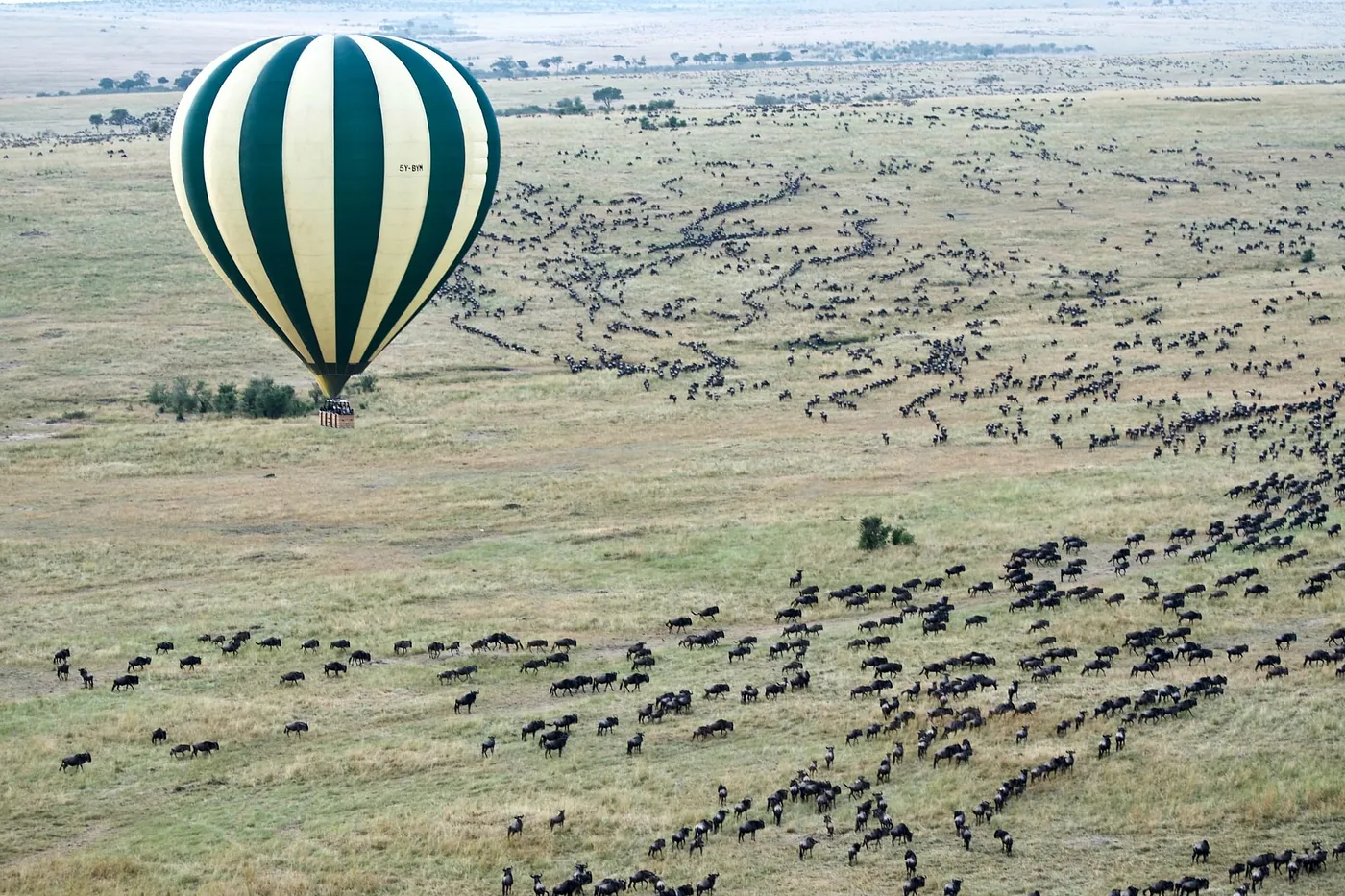Great Migration Safari Experience: Witness Africa’s Wild Heart
Experience one of nature’s most spectacular events—the Great Migration. Every year, over a million animals, including wildebeest, zebras, and antelopes, embark on an awe-inspiring journey across the Serengeti and into Kenya’s Masai Mara. Whether you’re planning a Serengeti migration safari or a Masai Mara wildebeest crossing, this adventure promises memories that last a lifetime.
What Makes the Great Migration So Special?
Nature’s Epic Journey:
The Great Migration isn’t just a movement of animals—it’s one of nature’s most colossal spectacles. Over a million wildebeest, zebras, and antelopes participate in this epic journey, driven by an innate need to find fresh, green pastures. This mass movement is a dynamic demonstration of survival and resilience, showcasing the intricate balance of nature in a way that has fascinated both scientists and travelers for generations.
Extraordinary Wildlife Behaviors:
This event is a living classroom of evolution and adaptation. The animals’ coordinated movements, social interactions, and collective decision-making reveal complex behaviours that have evolved over millennia. Observing how herds navigate vast landscapes, adapt to shifting conditions, and respond to environmental cues offers insights into the instincts that drive life in the wild.
Dramatic River Crossings:
Perhaps the most thrilling chapter of this saga is the perilous river crossings. As the herds face the powerful currents of rivers like the Grumeti and Mara, they must also contend with lurking predators, including stealthy crocodiles. These high-stakes crossings are a dramatic testament to the animals’ survival instincts, providing an adrenaline-fueled glimpse into the raw challenges of life in the wilderness.
Wildebeest and Zebra—Africa’s most famous drifters
Great Migration | Wild Ones | Episode 11 | Free Documentary Nature
Seasonal Wonders and Timing:
The migration’s timing is as critical as its scale. While the Serengeti serves as the backdrop for this journey over several months, the crescendo of activity reaches its peak in Kenya’s Masai Mara—typically between August and October. During these months, dynamic weather patterns and blooming landscapes create an ever-changing environment where every moment offers a new surprise, from the appearance of newborn calves to the intensified presence of predators.
Cultural and Ecological Impact:
Beyond the visual spectacle, the Great Migration has profound cultural and ecological significance. For local communities, the migration has inspired legends and traditions that are deeply woven into the fabric of regional heritage. Ecologically, the movement of such vast herds helps shape the landscape—promoting soil fertility, encouraging plant growth, and sustaining predator-prey relationships that maintain the delicate balance of the ecosystem.
Insider Tips for an Unforgettable Safari
Plan Ahead for a Seamless Adventure:
The Great Migration Safari Experience is truly a once-in-a-lifetime. To ensure you don’t miss any of the action, book your safari well in advance—especially if you’re aiming for peak times like the Serengeti calving season (January to March) or the intense Mara River crossings (July to October). Early planning also lets you secure premium accommodations and exclusive viewing spots, whether you’re embarking on a Serengeti migration safari or a focused Masai Mara wildebeest crossing.
Prepare Your Gear for Every Moment:
An unforgettable African safari demands smart packing. Besides the essentials—such as binoculars, a high-quality camera, and layered clothing—consider packing a lightweight daypack for water, snacks, and sun protection. Even during the dry season, mornings can be chilly, so it’s wise to have extra layers ready. A portable power bank and extra memory cards can also be game changers for capturing every memorable moment on your African safari itinerary.
Choose the Viewing Experience That Suits You Best:
Every mode of viewing offers its own unique perspective on the Great Migration Safari Experience.
- Guided Game Drives: Enjoy the comfort and safety of a four-wheel-drive vehicle, perfect for accessing remote areas with expert guidance.
- Minibus Rides: These offer a more intimate viewing experience, with the flexibility to stop and savour the moment.
- Hot-Air Balloon Flights: For a bird’s-eye view of the massive herds and sprawling landscapes, a hot-air balloon ride provides a truly breathtaking panorama. Each option allows you to witness the raw beauty of nature from different angles.

Leverage Local Insights for Hidden Gems:
Local guides are invaluable when it comes to discovering the lesser-known secrets of the migration routes. Their firsthand knowledge can lead you to the best viewing spots, from quiet corners away from the main routes to hidden areas where the wildlife thrives. Engaging with local experts not only enriches your safari experience but also supports community-based tourism, ensuring that your Great Migration Safari Experience is authentic and sustainable.
The Great Migration Calendar: Month-by-Month Breakdown
This is not just animal movement — it’s nature’s greatest theatre. 2+ million wildebeests, zebras, and gazelles roam the Serengeti-Mara ecosystem year-round in a giant loop. Timing is everything.
| 🗓️ Month | Where the Herds Are | What’s Happening |
|---|---|---|
| January – March | Southern Serengeti (Ndutu area), Tanzania | 🍼 Calving season. Thousands of babies are born daily. Predators everywhere. Great for drama and action. |
| April – May | Moving northwest through central Serengeti | 🌧️ Rainy season. Herds start moving. It’s a good time for value travel, but roads can be tricky. |
| June | Western Serengeti and Grumeti region | 🐊 River crossings begin at Grumeti. Wildlife builds tension. Great for photographers. |
| July – August | Northern Serengeti into Maasai Mara, Kenya | 🏞️ Legendary Mara River crossings. Peak safari season. Balloon safaris are pure magic now. |
| September – October | Maasai Mara, Kenya | 🌿 Grazing in Mara plains. Predators on the hunt. Still excellent for sightseeing and ballooning. |
| November – December | Southward back to Serengeti | 🌧️ Herds return to Tanzania. Scenic journeys through the eastern corridor. Low-season perks. |
Exploring Beyond the Migration
Extended Safari Itineraries with Mtembezi Safaris:
While the Great Migration Safari Experience is a spectacular event in its own right, your journey with Mtembezi Safaris doesn’t end there. Venture further to explore the full breadth of Africa’s wild wonders. Beyond the migration, both the Serengeti and Masai Mara boast an incredible array of wildlife. Consider extending your trip with additional safari itineraries that include bush walks (where permitted), in-depth cultural tours, and visits to innovative conservation projects. This well-rounded approach enriches your African safari itinerary and deepens your connection with the natural environment.
Interactive and Authentic Local Experiences:
At Mtembezi Safaris, we believe that the journey is as important as the destination. Enhance your adventure by immersing yourself in local experiences that showcase the region’s vibrant culture and rich biodiversity. Enjoy traditional Maasai cultural performances that offer insights into local customs and heritage. Alternatively, join a conservation tour to learn about the efforts dedicated to protecting the delicate ecosystems that support the Great Migration. These interactive experiences not only add depth to your safari but also support sustainable tourism and community empowerment.
Embrace a holistic safari adventure that goes beyond witnessing the breathtaking river crossings and animal herds. With Mtembezi Safaris, every moment—from exploring hidden trails to engaging with local communities—becomes part of an unforgettable African journey.
Don’t Wait: Your Journey Awaits
Embarking on a Great Migration Safari Experience is more than just a trip—it’s a journey into the heart of Africa’s wilderness. Whether you’re a seasoned traveler or a first-time adventurer, our expert team at Mtembezi Safaris is here to guide you every step of the way.
Ready to begin your adventure?
Book Now or Contact Us for more information and to secure your spot on this unforgettable journey.

